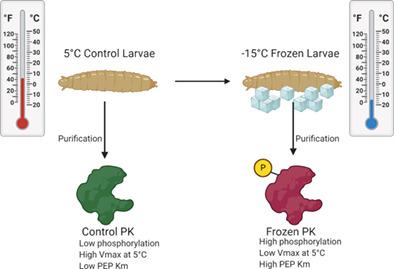当前位置:
X-MOL 学术
›
Insect Mol. Biol.
›
论文详情
Our official English website, www.x-mol.net, welcomes your
feedback! (Note: you will need to create a separate account there.)
Regulation of an important glycolytic enzyme, pyruvate kinase, through phosphorylation in the larvae of a species of freeze‐tolerant insect, Eurosta solidaginis
Insect Molecular Biology ( IF 2.3 ) Pub Date : 2020-12-06 , DOI: 10.1111/imb.12687 J Abboud 1 , S R Green 1 , M B Smolinski 1 , K B Storey 1
Insect Molecular Biology ( IF 2.3 ) Pub Date : 2020-12-06 , DOI: 10.1111/imb.12687 J Abboud 1 , S R Green 1 , M B Smolinski 1 , K B Storey 1
Affiliation

|
Larvae of the goldenrod gall fly, Eurosta solidaginis, rely on a freeze tolerance strategy to survive the sub‐zero temperatures of Canadian winter. Critical to their survival is the accumulation of polyol cryoprotectants and global metabolic rate depression, both of which require the regulation of glycolysis and reorganization of carbohydrate metabolism. This study explored the role that pyruvate kinase (PK) regulation plays in this metabolic reorganization. PK was purified from control (5 °C‐acclimated) and frozen (−15 °C‐acclimated) larvae and enzyme kinetic properties, structural stability, and post‐translational modifications were examined in both enzyme forms. The Km phosphoenolpyruvate (PEP) of frozen PK was 20% higher than that of control PK, whereas the Vmax of frozen PK was up to 50% lower than that of control PK at the lowest assay temperature, suggesting inhibition of the enzyme during the winter. Additionally, the activity and substrate affinity of both forms of PK decreased significantly at low assay temperatures, and both forms were regulated allosterically by a number of metabolites. Pro‐Q™ Diamond phosphoprotein staining and immunoblotting experiments demonstrated significantly higher threonine phosphorylation of PK from frozen animals while acetylation and methylation levels remained constant. Together, these results indicate that PK exists in two structurally distinct forms in E. solidaginis. In response to conditions mimicking the transition to winter, PK appears to be regulated to support metabolic rate depression, the accumulation of polyol cryoprotectants, and the need for extended periods of anaerobic carbohydrate metabolism to allow the animal to survive whole‐body freezing.
中文翻译:

一种重要的糖酵解酶丙酮酸激酶的调节,通过一种耐冻昆虫幼虫的磷酸化,Eurostasolidaginis
黄花瘿蝇的幼虫Eurostasolidaginis依靠抗冻策略在加拿大冬季零下的温度下生存。它们生存的关键是多元醇冷冻保护剂的积累和整体代谢率降低,这两者都需要调节糖酵解和重组碳水化合物代谢。本研究探讨了丙酮酸激酶 (PK) 调节在这种代谢重组中的作用。从对照(5°C 驯化)和冷冻(-15°C 驯化)幼虫中纯化 PK,并在两种酶形式中检查酶动力学特性、结构稳定性和翻译后修饰。冷冻 PK的 K m磷酸烯醇丙酮酸 (PEP) 比对照 PK 高 20%,而 V max在最低测定温度下,冷冻 PK 的 PK 比对照 PK 低 50%,表明该酶在冬季受到抑制。此外,两种形式的 PK 的活性和底物亲和力在低测定温度下显着降低,并且这两种形式都受到许多代谢物的变构调节。Pro-Q™ Diamond 磷蛋白染色和免疫印迹实验表明,冷冻动物的 PK 苏氨酸磷酸化水平显着提高,而乙酰化和甲基化水平保持不变。总之,这些结果表明 PK 在E.solidaginis 中以两种结构不同的形式存在. 为响应模拟向冬季过渡的条件,PK 似乎被调节以支持代谢率降低、多元醇冷冻保护剂的积累以及延长无氧碳水化合物代谢时间以使动物能够在全身冷冻中存活。
更新日期:2020-12-06
中文翻译:

一种重要的糖酵解酶丙酮酸激酶的调节,通过一种耐冻昆虫幼虫的磷酸化,Eurostasolidaginis
黄花瘿蝇的幼虫Eurostasolidaginis依靠抗冻策略在加拿大冬季零下的温度下生存。它们生存的关键是多元醇冷冻保护剂的积累和整体代谢率降低,这两者都需要调节糖酵解和重组碳水化合物代谢。本研究探讨了丙酮酸激酶 (PK) 调节在这种代谢重组中的作用。从对照(5°C 驯化)和冷冻(-15°C 驯化)幼虫中纯化 PK,并在两种酶形式中检查酶动力学特性、结构稳定性和翻译后修饰。冷冻 PK的 K m磷酸烯醇丙酮酸 (PEP) 比对照 PK 高 20%,而 V max在最低测定温度下,冷冻 PK 的 PK 比对照 PK 低 50%,表明该酶在冬季受到抑制。此外,两种形式的 PK 的活性和底物亲和力在低测定温度下显着降低,并且这两种形式都受到许多代谢物的变构调节。Pro-Q™ Diamond 磷蛋白染色和免疫印迹实验表明,冷冻动物的 PK 苏氨酸磷酸化水平显着提高,而乙酰化和甲基化水平保持不变。总之,这些结果表明 PK 在E.solidaginis 中以两种结构不同的形式存在. 为响应模拟向冬季过渡的条件,PK 似乎被调节以支持代谢率降低、多元醇冷冻保护剂的积累以及延长无氧碳水化合物代谢时间以使动物能够在全身冷冻中存活。











































 京公网安备 11010802027423号
京公网安备 11010802027423号